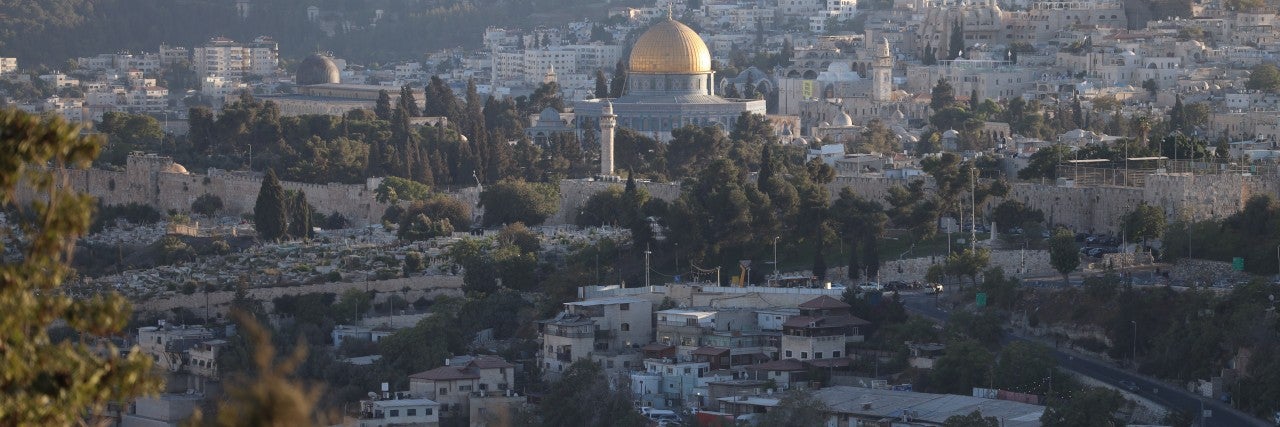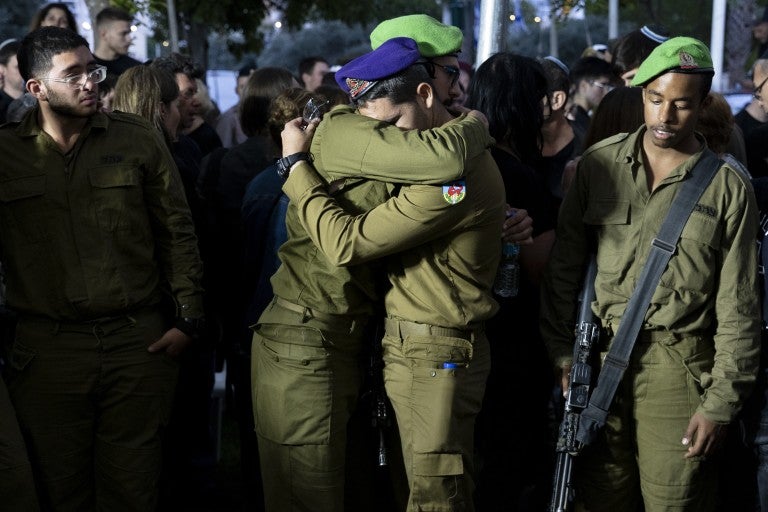April 25, 2023
The Temple Mount, known in Hebrew as “Har HaBayit,” located in the Old City of Jerusalem, is considered one of the holiest sites in Judaism and Islam, and is central to the Christian Gospels. It is also known as Haram al-Sharif in Islam, which means "The Noble Sanctuary." For decades it has been one of the most politically sensitive areas globally.
In early April, as Jews celebrated Passover and Muslims marked Ramadan, tensions flared at the holy site amid an Israeli police operation to remove a group of Palestinians who had stockpiled rocks, cudgels, and improvised explosives, allegedly for use against Jewish visitors to the site and had been reportedly planned weeks in advance by the rioters.
The police action sparked international condemnation, especially among Muslims, and was used as justification by terror groups to carry out terror and rocket attacks against Israel.
Here is what to know about Jerusalem’s Temple Mount, the status quo agreement governing the site, and the role it plays in the Arab-Israeli Conflict.
Why is the Temple Mount/ Haram Al-Sharif important?
The Temple Mount has a long and complex history, with significant religious and historical importance for each of the Abrahamic faiths. For Jews, the Temple Mount is the holiest site in Judaism and is where the First and Second Holy Temples, which were destroyed in ancient times, once stood. The area served as the spiritual center of the Jewish people for centuries, and it remains a focal point of Jewish liturgy and collective identity.
For Muslims, Al-Aqsa at the Haram Al-Sharif was the destination of the Prophet Muhammad on a miraculous Night Journey from Mecca, according to Islamic tradition. From the stone housed in the Dome of the Rock, he is said to have ascended to heaven in a prophetic vision to meet the biblical prophets. It was also the first site toward which Muhammad and his followers directed prayers before they started facing the Ka’ba in Mecca. As a result, the sacred precinct of Al-Aqsa Mosque is considered one of the three holiest sites in Islam.
How did Israel gain control over the Temple Mount?
Israel gained control over the Temple Mount during the 1967 Six-Day War when Israeli forces captured the Old City of Jerusalem, which includes the Temple Mount, from Jordan.
After Israel took control of the Temple Mount, it granted the Islamic Waqf (see below) responsibility for the administration of the site. The Islamic Waqf was first established by Muslim military leader Saladin in 1187 CE, following his recapture of Jerusalem from the Crusaders.
What is the status quo agreement on the Temple Mount and what is the Islamic Waqf?
The "status quo" on the Temple Mount/Haram Al-Sharif is an informal understanding that involves Israel and the Islamic Waqf, the Muslim religious trust that administers the site. The status quo is intended to preserve the religious and cultural significance of the site, while also maintaining order and security.
Shortly after Israel took control of Jerusalem in 1967, then-Israeli Defense Minister Moshe Dayan, who personally oversaw the capture of East Jerusalem during the war, recognized the historic magnitude of the event, but also the sensitivities associated with the Temple Mount. Dayan stated that “we have returned to the holiest of our places, never to be parted from them again….We did not come to conquer the sacred sites of others or to restrict their religious rights, but rather to ensure the integrity of the city and to live in it with others in fraternity.”
It is under this mindset that the status quo was honored.
Under the status quo, Israel maintains overall security control of the Temple Mount, while the Waqf is responsible for day-to-day management and maintenance of the site. The Waqf is responsible for ensuring that the site is open to Muslim worshipers and visitors, and for protecting the religious and cultural heritage of the site.
In practice, this means that Israeli police manage access to the site and monitor activity, while the Waqf is responsible for managing the site's religious affairs, such as prayer times and religious services. Jewish visitors are allowed to visit the Temple Mount during certain times, but are not permitted to pray there, in order to avoid provoking interreligious conflict. Instead, Jews are allowed to pray at the Western Wall, which is located adjacent to the Temple Mount and is considered the closest accessible site to the Holy of Holies, the innermost chamber of the ancient Jewish Temple. Additionally, there is ongoing debate and controversy within the Jewish community about whether Jews should be allowed to pray on the Temple Mount. The Chief Rabbinate of Israel and many other rabbinic authorities prohibit Jews from visiting the Temple Mount for religious reasons pertaining to concerns about purity and desecration of the site’s sanctity.
How does Israel maintain security on the Temple Mount/Haram Al-Sharif?
Israel maintains security over the Temple Mount through a combination of measures, including physical barriers, checkpoints, and security personnel such as the Israel Police and Border Police.
Access to the Temple Mount is heavily regulated for non-Muslims, and visitors are required to pass through a security checkpoint before entering the site. There are nine entrances to the site, where Muslims have eight, which they are permitted to freely pass through, while the remaining entrance is for non-Muslims. Israeli police are stationed at various points around the perimeter of the site, and they monitor activity on the Temple Mount using closed-circuit television cameras and other surveillance equipment.
The security measures implemented by Israel have been a source of controversy and tension, as some Palestinians view them as a violation of their religious freedom and cultural heritage. However, Israeli officials argue that these measures are necessary to maintain order and prevent violence, and they have pointed to past incidents of violence and terrorism on the Temple Mount, such as the riots last week, as evidence of the need for heightened security measures.
What is Jordan’s role?
From 1948 to 1967, Jordan controlled the West Bank and East Jerusalem, including the Old City of Jerusalem and the Temple Mount complex. During this time, the 35 synagogues of Jerusalem’s Old City were destroyed or used to house animals and refuse, Jewish cemeteries were vandalized, and Jewish Torah scrolls and holy books were plundered and burned. Jews were also forbidden from praying or visiting the Western Wall. Jordan’s occupation came to an end as a result of the 1967 Six-Day War when Israel captured these territories.
The 1994 Israel-Jordan peace treaty established a special relationship between Jordan and the Islamic holy sites in Jerusalem.
Under the treaty, Jordan has the role of custodian of the Muslim holy sites in Jerusalem, including the Haram al-Sharif/Temple Mount. This is carried out by the Islamic Waqf in Jerusalem which is part of the Jordanian Ministry of Awqaf and Islamic Affairs. Jordan also provides financial support for the maintenance and restoration of the sites. Most recently Jordan’s role was documented in last month’s quadrilateral meeting with American, Israeli, Jordanian, and Egyptian officials in Sharm el-Sheikh. In the joint communique the four countries “reiterated the commitment of upholding unchanged the historic status quo at the Holy Sites in Jerusalem, both in word and in practice, and reaffirmed in this context the importance of the Hashemite Custodianship/special role of the Hashemite Kingdom of Jordan.”
What is the Palestinian relationship with the Haram al-Sharif?
The Palestinians, as represented by the Palestinian Authority, have a role in the administration of the Temple Mount in Jerusalem, which is primarily exercised through the Islamic Waqf.
In 2013, the Palestinian Authority and Jordan signed an agreement that reinforced the Hashemite Kingdom’s role in managing the Waqf while formalizing that Jordan will consult and coordinate with the PA on the Haram al-Sharif when necessary. In 2019 the role of the PA was further expanded when a new Aqsa council was expanded allowing Palestinians to have greater control of Muslim holy sites in Jerusalem.
More generally, the Palestinians also see the Haram al-Sharif as a key symbol of their national identity and aspirations for statehood. The site is viewed by many Palestinians as a symbol of their historical and cultural ties to Jerusalem, and as a central component of any future Palestinian state.
How do Palestinian terror groups incite violence using the Haram al-Sharif?
Palestinian terror groups such as Hamas, Palestinian Islamic Jihad, and others like the Al-Aqsa Martyrs Brigade have abused the spiritual significance of the holy site as a means to incite violence against Israel.
Oftentimes these terror groups will use inflammatory language and rhetoric that is spread through Palestinian media, and especially social media. For example, they may spread false rumors or conspiracy theories about Israeli intentions to damage or destroy Islamic holy sites on the Temple Mount, or they may call for "defending" the site against perceived threats from Israel. Footage of the aforementioned Israeli police operation to disarm and remove a group of Palestinians planning violence at the Al-Aqsa Mosque on the Temple Mount spread widely on social media across the Arab world. Using this, terror groups such as Palestinian Islamic Jihad hailed the rockets from Lebanon as “a heroic operation against the Israeli crimes in the Al-Aqsa Mosque.”
Terror groups use violent actions such as throwing rocks, firebombs, or other projectiles at Israeli police or Jewish visitors to the site, in an attempt to provoke a response and escalate tensions. In some cases, they have also used firearms or other weapons to carry out attacks on Israeli police or civilians in the area.
Furthermore, as was the case in the aforementioned recent experience, terror groups will use tensions on the Temple Mount as justification to launch rockets at Israel from the Gaza Strip or elsewhere, such as Lebanon, as well as to carry out terror attacks within Israel.
Is Israel going to change the status quo on the Temple Mount?
Since Israel gained control over the Temple Mount in 1967, successive Israeli governments, including the current government under Prime Minister Benjamin Netanyahu, have maintained that there will be no changes to the status quo.
Nevertheless, a very small number Jewish groups and Israeli political leaders advocate for more Jewish access and control over the site, including increased Jewish visitation and prayers, while some Muslim groups have protested against Israeli security measures and perceived attempts to change the status quo.
American Jewish Committee has stressed the importance of freedom of worship and maintaining the status quo on the Temple Mount. Likewise, AJC believes that denying the historical and religious significance of the site to either Jews or Muslims is a political provocation that should be condemned.


